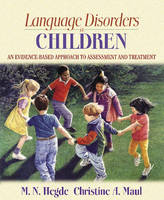
Language Disorders in Children
Pearson (Verlag)
978-0-205-43542-5 (ISBN)
- Titel ist leider vergriffen;
keine Neuauflage - Artikel merken
M.N. Hedge and Christine Maul have constructed a text useful for students, instructors, and practicing clinicians alike. Language Disorders in Children: An Evidence-Based Approach to Assessment and Treatment provides an all-encompassing look at the treatment of language disorders in various clinical populations, including children with autism, developmental disability, hearing loss, and neurogolical involvment.
A review of research evidence in every chapter allows students and practicing clinicians to critically evaluate procedures before accepting or rejecting them. Jargon-free descriptions of theoretical concepts and treatment procedures ensures clinicians can readily implement the procedures in their practice. Display boxes, margin notes, chapter summaries, and study guides engage the learner through interesting stories and illuminating case studies.
Each chapter concludes with “Chapter Summary” and “Study Guide.”
I. AN INTRODUCTION TO LANGUAGE AND LANGUAGE DISORDERS.
1. Language and Verbal Behavior.
Rational versus Empirical Approaches
Language versus Verbal Behavior
Linguistic Analysis of Language
Linguistic Explanations of Language and Language Learning
Analysis of Verbal Behavior
Language and Communication
Verbal and Nonverbal Communication
2. An Overview of Language Disorders in Children.
What are Language Disorders in Children?
Language Disorders by any Other Name
Prevalence and Incidence of Language Disorders
Varieties of Language Disorders
Risk Factors for Language Disorders
Effects of Language Disorders
3. Children with Specific Language Impairment (SLI).
A Description of SLI
Early Communication Deficits
Language and Speech Characteristics of Children with SLI
Causes, Correlations, and Explanations
Is SLI Truly Specific to Language?
Prognosis for Children with SLI
Understanding SLI: An Integrative Discussion
II. ASSESSMENT AND TREATMENT OF LANGUAGE DISORDERS.
4. Assessment, Measurement, and Diagnosis.
Assessment, Measurement, and Diagnosis
An Initial Judgment: Screening
Assessment and Measurement Procedures
Making a Diagnosis
Recommendations: Talking with the Family Members
Writing a Diagnostic Report
5. Treatment of Language Disorders: An Evidence-Based Framework.
What is Evidence-Based Practice?
An Overview of Treatment Research
Guidelines to Select: A Hierarchy of Treatment Research Evidence
Treatment Research in Children’s Language Disorders
From the Beginning to the End: An Overview of Treatment
Principles of Target Behavior Selection
Sequence of Target Behaviors
Specifying Target Behaviors
Principles of Treatment Sequencing
Judging Improvement: Need for Baselines
Treatment Principles
Structure of Treatment Sessions
Treatment Trials
Probes for Generalized Productions
Criteria for Clinical Decisions
Post-Dismissal Follow-up and Booster Treatment
6. Evidence-Based Treatment Techniques.
Starting with the Clinical and Moving to the Natural: Fading
Putting the Child on the Right Path: Modeling
Giving a Hint: Prompting
Building More Complex Skills: Shaping
Giving a Helping Hand: Manual Guidance
Just Telling Them: Instructions
Getting Them to Say More: Techniques to Increase Language Skills
Strengthening the Language Skills: Varying the Consequences
Getting the Children’s Cooperation: Decreasing the Troublesome Behaviors
Breaking the Rules: Modifying Procedures
7. Establishing Basic Language Skills.
Selecting Basic Language Skills
Establishing Baselines
Teaching Basic Language Skills
Sequencing Treatment
Preparing for the Next Stage
8. Expanding Language Skills.
Expanding Previously Learned Skills
Teaching Varied Sentence Types
Teaching Conversational Speech
Teaching Narrative Skills
Teaching Abstract Language Skills
Integrating Conversational Skills — Putting it all Together
Moving to Nonclinical Settings
9. Maintaining Language Skills: A Family Partnership.
Maintenance: Going Beyond Clinical Treatment
Generalization: A Misunderstood Concept
Maintenance: Skills That Last in Natural Settings
Bypassing the Problem: Home-Based Treatment of Children
Strategies to Promote Skill Maintenance
Follow-up and Booster Treatment
10. Supporting Academic Performance: Language and Literacy.
Trends in Special Education Service Delivery
Trends in Literacy Instruction
Assessment of Reading and Writing
Intervention for Reading and Writing
Beyond Assessment and Intervention: Advancing the Literacy Knowledge Base and Advocating for Effective Literacy Practices 11. Children in a Multicultural Society: Implications for Assessment and Treatment.
Cultural Competency: What Does it Mean and How Does it Help?
Differences Are Not Disorders
Understanding Each Other: Working with Interpreters
Nonbiased Assessment of Multicultural Children
Treatment for Multicultural Children: A Question of Generality
Working with Children and Families of Varied Cultural Backgrounds
III. LANGUAGE DISORDERS IN SPECIFIC POPULATIONS OF CHILDREN.
12. Children with Developmental Disability
Developmental Disability: Characteristics
Causes, Correlations, and Explanations
Speech and Language Skills
Assessment and Treatment Modifications
13. Children with Autism and Other Pervasive Developmental Disorders.
Pervasive Developmental Disorders or Autism Spectrum Disorders?
Prevalence of Pervasive Developmental Disorders
Causes, Correlations, and Explanations
Language and Communication in Children with ASD/PDD
Assessment and Treatment Modifications
14. Language Disorders in Three Populations: Children with Traumatic Brain Injury, Cerebral Palsy, and Hearing Loss.
Children with Traumatic Brain Injury
Children with Cerebral Palsy
Children with Hearing Loss
15. Augmentative and Alternative Communication.
Augmentative and Alternative Communication: Definition and Types
Assessing Communicative Skills in Children who are Nonverbal or Minimally Verbal
Assessing Physical, Sensory, and Cognitive Skills
Looking for the Best Fit: Selecting an AAC System
Supporting Children Using AAC in Natural Settings: Modifications to Treatment Procedures
A Look into the Future: Technology, Communication, and Children
Glossary.
References.
| Erscheint lt. Verlag | 8.11.2005 |
|---|---|
| Sprache | englisch |
| Maße | 191 x 232 mm |
| Gewicht | 910 g |
| Themenwelt | Medizin / Pharmazie ► Gesundheitsfachberufe ► Logopädie |
| Medizin / Pharmazie ► Medizinische Fachgebiete ► Pädiatrie | |
| Sozialwissenschaften ► Soziologie | |
| ISBN-10 | 0-205-43542-4 / 0205435424 |
| ISBN-13 | 978-0-205-43542-5 / 9780205435425 |
| Zustand | Neuware |
| Haben Sie eine Frage zum Produkt? |
aus dem Bereich


